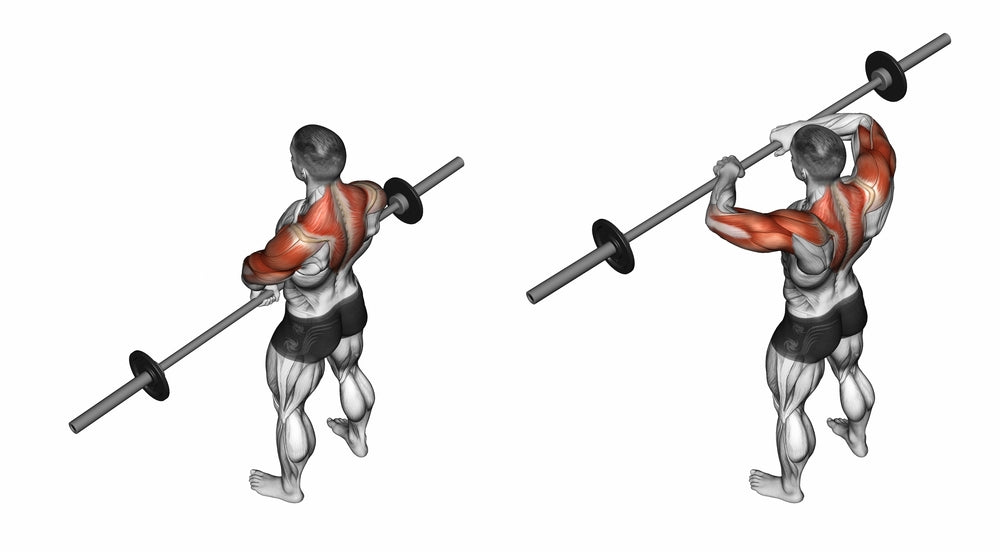Exercise Anatomy
UPRIGHT ROW
The Upright Row is a compound exercise targeting the shoulder muscles, primarily the deltoids. Its unique aspect lies in its ability to work the lateral deltoid head effectively, enhancing shoulder width. Incorporate this exercise to build well-rounded shoulders and achieve a broader upper body appearance.

Major Muscles and Actions Involved
During the Upright Row, the primary joint action is shoulder abduction, where the arms move away from the body in a vertical plane. This movement primarily engages the lateral deltoid head, responsible for the outer part of the shoulder. Additionally, the exercise activates the trapezius, rhomboids, and the muscles of the upper back, contributing to overall shoulder and upper body development.

Sports Uses
The Upright Row is particularly beneficial for athletes involved in sports that require strong shoulder and upper body development. This exercise can enhance performance in sports such as basketball, swimming, and volleyball, where powerful shoulder movements are essential for shooting, swimming strokes, and overhead hitting actions. The Upright Row aids in building the strength and stability needed for optimal performance in these activities.
Exercise Tips
- Technique Matters: Maintain proper form by lifting the weight with a controlled motion, ensuring that the shoulders, not the wrists, are doing the work. This reduces the risk of injury and maximizes muscle engagement.
- Full Range of Motion: Execute a complete range of motion to fully activate the deltoids. Raise the barbell or dumbbells until your elbows reach shoulder height, and lower them back down under control to ensure optimal muscle recruitment.
- Moderate Weight: Avoid excessive weight to prevent strain on the shoulder joints. Opt for a weight that challenges your muscles without compromising form, promoting safer and more effective training.
- Mind Your Grip: Maintain a grip slightly wider than shoulder-width to target the lateral deltoids effectively. This grip helps distribute the workload evenly and minimizes stress on the wrists.
- Variations for Diversity: Experiment with different variations, such as using a barbell, dumbbells, or cables, to keep your workouts dynamic. This not only adds variety to your routine but also targets the muscles from different angles for comprehensive development.
Bonus Tip: Controlled Breathing: Inhale as you lower the weight and exhale as you lift. Consistent breathing enhances stability and helps maintain control throughout the movement, contributing to a more effective Upright Row.
Upright Row VS the seated row
The upright row and seated row exercises are distinct strength-training movements that target different muscle groups and serve varied purposes in a workout routine.
Muscles Targeted:
- Upright Row: Primarily targets the deltoids (shoulder muscles), specifically the lateral or outer part. It also engages the trapezius and upper traps to a certain extent.
- Seated Row: Targets the muscles of the upper back, particularly the latissimus dorsi (lats), rhomboids, and middle traps. It also involves the biceps and rear deltoids.
Body Position:
- Upright Row: Typically performed while standing with a narrow grip on a barbell or dumbbells, lifting the weights straight up toward the shoulders.
- Seated Row: Usually performed on a cable machine or rowing machine while seated. The individual pulls a handle or bar towards the torso in a rowing motion.
Joint Movement:
- Upright Row: Involves a vertical movement of the arms, with the elbows lifting the weight directly upward.
- Seated Row: Involves horizontal pulling, with the elbows bending and extending in a rowing motion towards the body.
Primary Function:
- Upright Row: Primarily focuses on developing shoulder strength and width, enhancing the lateral aspect of the deltoids.
- Seated Row: Concentrates on building the muscles of the upper and mid-back, promoting better posture and overall back development.
Equipment:
- Upright Row: Can be performed with barbells, dumbbells, or cable machines.
- Seated Row: Typically involves cable machines, rowing machines, or resistance bands.
Risk of Injury:
- Upright Row: Some individuals may experience shoulder discomfort or impingement, especially with improper form or excessive weight.
- Seated Row: Generally considered a safer exercise for the back and shoulders, with less risk of strain or injury when performed correctly.
Ultimately, the choice between the upright row and seated row depends on your fitness goals and the specific muscle groups you want to target. Combining both exercises in a well-rounded workout routine can contribute to overall upper body strength and development.

Want to Learn More?
Try our premium ebook, Exercise Anatomy and Biomechanics: Ultimate Guide.
Satisfaction guaranteed.
